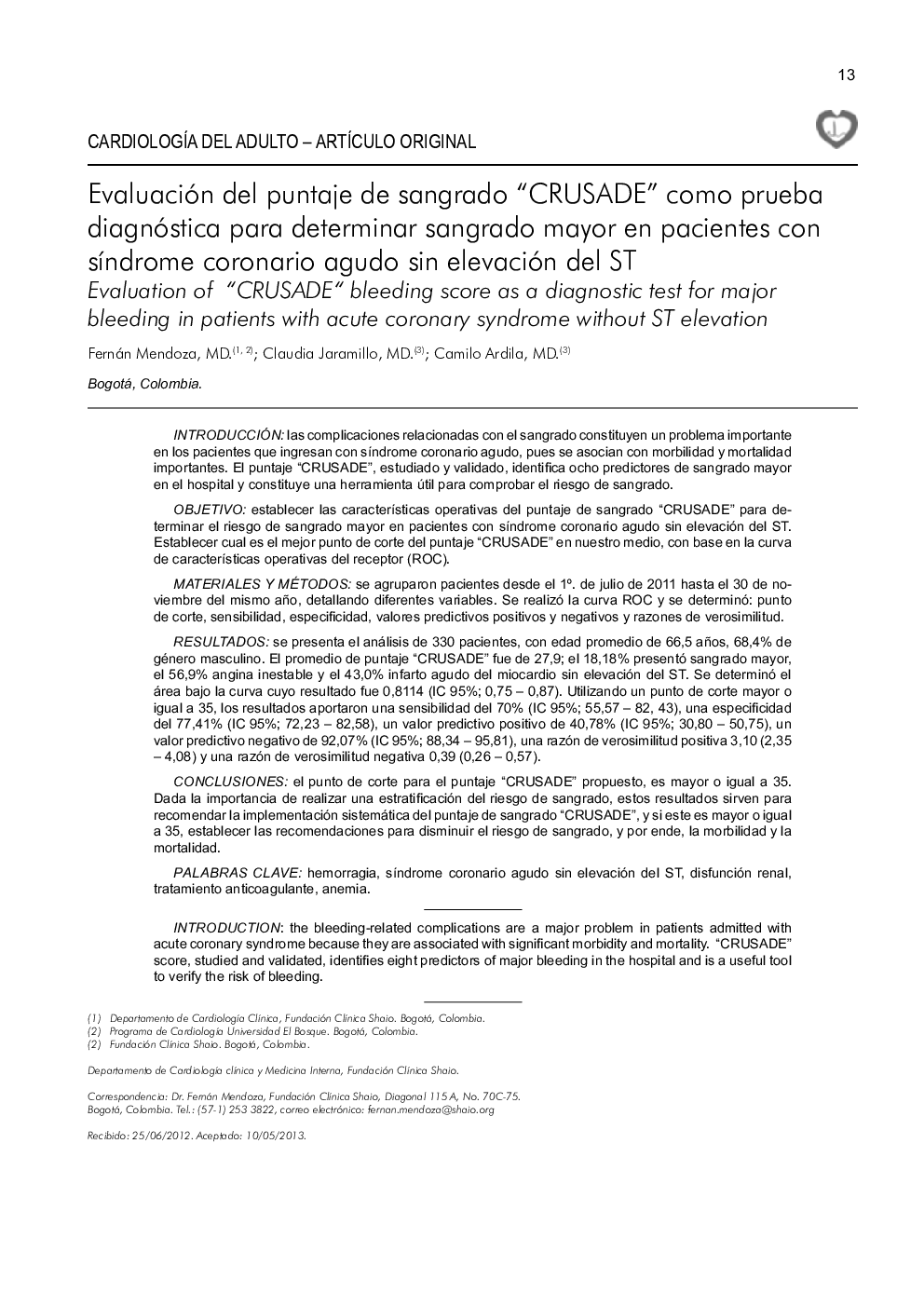| Article ID | Journal | Published Year | Pages | File Type |
|---|---|---|---|---|
| 3012344 | Revista Colombiana de Cardiología | 2014 | 11 Pages |
Introducciónlas complicaciones relacionadas con el sangrado constituyen un problema importante en los pacientes que ingresan con síndrome coronario agudo, pues se asocian con morbilidad y mortalidad importantes. El puntaje “CRUSADE”, estudiado y validado, identifica ocho predictores de sangrado mayor en el hospital y constituye una herramienta útil para comprobar el riesgo de sangrado.Objetivoestablecer las características operativas del puntaje de sangrado “CRUSADE” para determinar el riesgo de sangrado mayor en pacientes con síndrome coronario agudo sin elevación del ST. Establecer cual es el mejor punto de corte del puntaje “CRUSADE” en nuestro medio, con base en la curva de características operativas del receptor (ROC).Materiales y métodosse agruparon pacientes desde el 1°. de julio de 2011 hasta el 30 de noviembre del mismo año, detallando diferentes variables. Se realizó la curva ROC y se determinó: punto de corte, sensibilidad, especificidad, valores predictivos positivos y negativos y razones de verosimilitud.Resultadosse presenta el análisis de 330 pacientes, con edad promedio de 66,5 años, 68,4% de género masculino. El promedio de puntaje “CRUSADE” fue de 27,9; el 18,18% presentó sangrado mayor, el 56,9% angina inestable y el 43,0% infarto agudo del miocardio sin elevación del ST. Se determinó el área bajo la curva cuyo resultado fue 0,8114 (IC 95%; 0,75 – 0,87). Utilizando un punto de corte mayor o igual a 35, los resultados aportaron una sensibilidad del 70% (IC 95%; 55,57 – 82, 43), una especificidad del 77,41% (IC 95%; 72,23 – 82,58), un valor predictivo positivo de 40,78% (IC 95%; 30,80 – 50,75), un valor predictivo negativo de 92,07% (IC 95%; 88,34 – 95,81), una razón de verosimilitud positiva 3,10 (2,35 – 4,08) y una razón de verosimilitud negativa 0,39 (0,26 – 0,57).Conclusionesel punto de corte para el puntaje “CRUSADE” propuesto, es mayor o igual a 35. Dada la importancia de realizar una estratificación del riesgo de sangrado, estos resultados sirven para recomendar la implementación sistemática del puntaje de sangrado “CRUSADE”, y si este es mayor o igual a 35, establecer las recomendaciones para disminuir el riesgo de sangrado, y por ende, la morbilidad y la mortalidad.
Introductionthe bleeding-related complications are a major problem in patients admitted with acute coronary syndrome because they are associated with significant morbidity and mortality. “CRUSADE” score, studied and validated, identifies eight predictors of major bleeding in the hospital and is a useful tool to verify the risk of bleeding.Objectiveto establish the operational characteristics of the bleeding “CRUSADE” score to determine the risk of major bleeding in patients with acute coronary syndrome without ST elevation. Establish which is the best “CRUSADE” score cutoff in our environment, based on the curve of the receiver operating characteristics (ROC).Materials and methodspatients were grouped from July 1, 2011 to November 30, 2011, detailing different variables. The ROC curve was calculated and cut point, sensitivity, specificity, positive and negative predictive values and likelihood ratios were determined.Resultsthe analysis of 330 patients with mean age 66.5 years and 68.4% of male gender is presented. The average “CRUSADE” score was 27.9. 18.18% had major bleeding, 56.9% unstable angina, and 43.0% acute myocardial infarction without ST elevation. The area under the curve was determined and the result was 0.8114 (95% CI; 0.75 to 0.87). Using a cutoff point greater than or equal to 35, the results provided a sensitivity of 70% (95% CI, 55.57 to 82.43), a specificity of 77.41% (95% CI, 72.23 to 82.58), a positive predictive value of 40.78% (95% CI; 30.80 to 50.75), a negative predictive value of 92.07% (95% CI; 88.34 to 95.81), a positive likelihood ratio 3.10 (2.35 to 4.08) and a negative likelihood ratio 0.39 (0.26 to 0.57).Conclusionsthe cutoff point for the proposed “CRUSADE” score is greater than or equal to 35. Given the importance of conducting a risk stratification of bleeding, these results serve to recommend the systematic implementation of the “CRUSADE” bleeding score and if this is greater than or equal to 35, establish recommendations to reduce the risk of bleeding and consequently morbidity and mortality.
